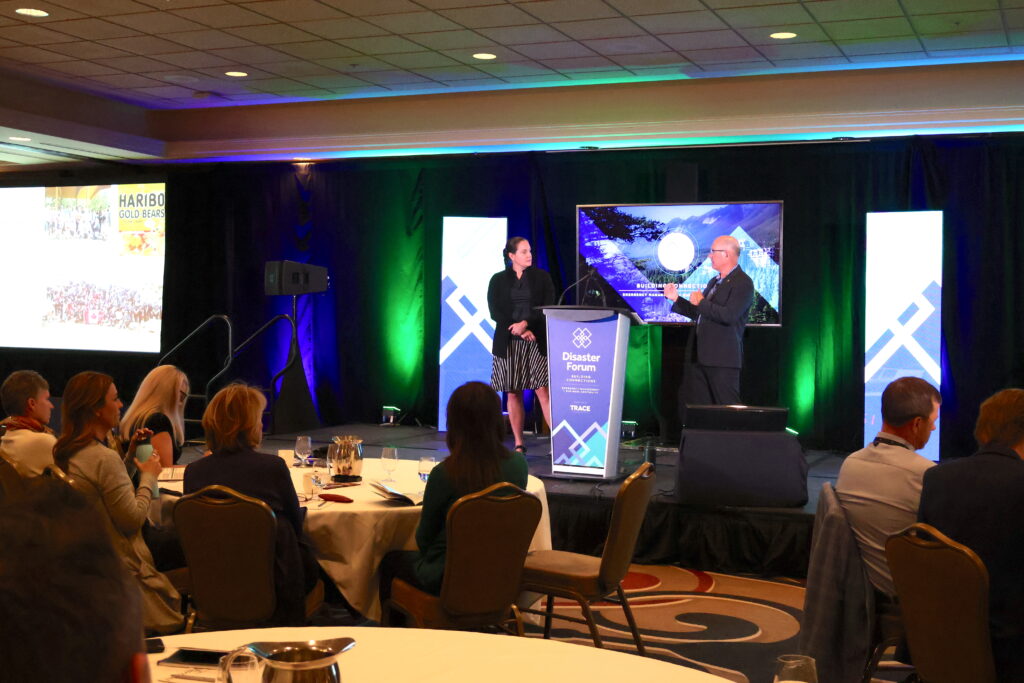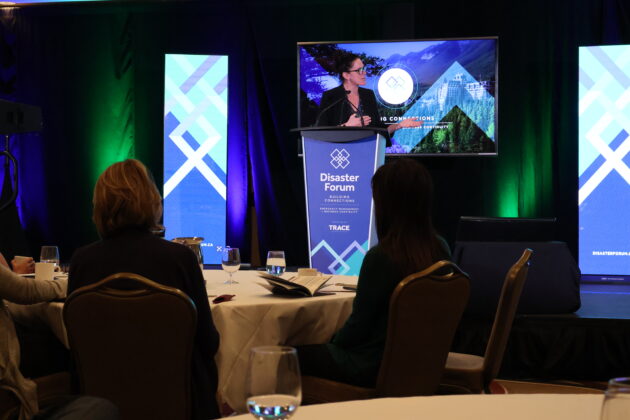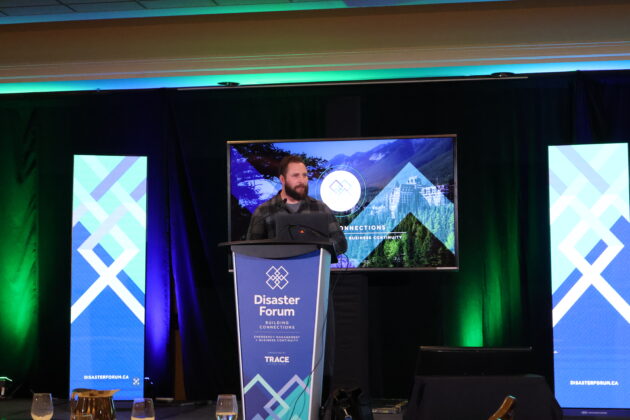
Emergency management experts discuss unspoken skills and challenges at Disaster Forum
October 31, 2023
By
Haley Nagasaki
The three-day Disaster Forum conference took place last week in Banff, Alta., bringing together emergency managers and other supporting industries nationwide.
 Susan Henry and Tom Sampson deliver the Disaster Forum keynote presentation. Photo: Annex Business Media
Susan Henry and Tom Sampson deliver the Disaster Forum keynote presentation. Photo: Annex Business Media Susan Henry, chief of the Calgary Emergency Management Agency (CEMA), and Tom Sampson, owner of 9Zero Solutions and previous CEMA chief, delivered the opening keynote speech at the Disaster Forum emergency management and business continuity conference last week at the iconic Fairmont Banff Springs Hotel.
From the President’s Hall Main Stage, the duo addressed the room full of attendees with vocations spanning academia, emergency management, and big industries such as the energy sector regarding the unspoken skills of emergency management. After a relentless season of flooding and wildfires, complicated EOC activations, stacked with the intricate task of managing casualties and evacuees, Henry stated: “the definition of big is not big enough.”
Personal management in public roles
With a busy summer season comes the need for emergency managers (EMs) to manage expectations. Henry spoke on the side of personal management in a public role, where the competing political or unionized interests becomes a balancing act as each group seeks information in real time, meanwhile organizations aspire to remain transparent especially when addressing notions of equal opportunity – to name only a small handful of the complexities.
Emergency managers are tasked with making million-dollar decisions with only 20-30 per cent of the information. They are not always welcomed into the communities in which they serve, and they must focus on relationship-building while navigating entrenched generational traumas.
Advertisement
The “facade” Sampson called it (in reference to the start of CEMA back in 2009) of having everything together on the outside while still building on the fly, is a constant struggle in this sector. Sampson advised that while some leaders prefer 90 per cent of the information before making decisions, beginning on a limited foundation and adjusting as time goes can be an appropriate approach for emergency services.
Henry also commented on the increasing political presence in the field, signalling regular “interactions with elected officials at every event.” She urged attendees to “never, ever say a number until the event is over. Whether it’s what you can handle or the number of deaths,” she said, reflecting on a time when the number of evacuees they stated they could take fell short.
Self-care and stress management were other recurring themes over the three-day event as a relatively new addition to the industry that previously lacked the languaging needed to address mental health. “I think most people who’ve been in emergency services for a protracted period of their life have some form of PTSD,” Sampson said, admitting he is included in that group.
Sampson listed a “multitude of ways to help people when they’re under stress,” from ensuring staff are spending enough time with their families, removing toxic personalities from the workplace, bringing stress-reduction modalities such as massage chairs and RMTs to work, and keeping team members well fed. On the topic of personal management and team motivation, “never underestimate the power of a really good cup of coffee,” Henry said.
“You’re never done. There’s always going to be another fire,” she continued, and “getting EOC to go home is like putting a five-year old to bed.” But at the end of the day, “nobody ever said your job is an empty inbox.
“All the little pieces are actually not so little;” she said, “they’re huge.” And “what we have to recognize is that sometimes, the best answer is ‘No,’ and that’s the hardest thing for us.”

Katherine Severson explores the meaning of stabilization. Photo: Annex Business Media
‘Getting stuck in size up’
Katherine Severson, director of emergency and protective services for the Town of Banff, spoke about the transition from emergency response to incident management. Severson expertly addressed how the principles of interoperability correlate to the principles of incident management, including how best to stabilize when “the baton hand off is not always smooth.”
Severson previously served with the Calgary Police Service and has been operating at her new role in Banff since August of this year. During her time in Calgary, one of her duties was to “execute transition; to be there when we were scaling up.” After witnessing the discomfort of that transition period, she became passionate about how to scale an incident from a “solely front lines response activity into that scaled up incident management team activation.”
Severson identified key targets and definitions, such as stabilization defined as “a state in which impacts are no longer worsening.”
However, stabilization is also a constant state to work towards: “a goal, a series of activities, and a state of being,” she said, outlining the crux for emergency managers and incident commanders.
Periods of transition might include transfer of command, such as “transferring from fire response to some kind of functional jurisdictions,” or transitional periods in which people are fatigued. “Tom and Sue did a great job touching on that from a leadership perspective,” she said.
Tensions arise through the juxtaposition of co-ordination vs. command, or the strategic vs. the tactical. “ICS teaches us how to manage the problems that arise from the response, and this can seem adversarial,” Severson pointed out. But at the end of the day, “messy is okay when transitioning from emergency response to incident management,” she said, while working around complicated principles of incident command and interoperability.

Grayson Cockett shares top tips after five years of EPIC podcast. Photo: Annex Business Media
Tough to say
“You can’t have the same people who respond to events be the ones responsible for preparing for them.” – Conrad Sauve
Grayson Cockett began his interactive presentation with this quote by the president and CEO of the Canadian Red Cross, the meaning of which alludes to the fact that both are full-time positions.
Cockett, co-host of the Emergency Preparedness in Canada (EPIC) podcast and Calgary-based healthcare disaster manager, employed a valuable tool during his session, an app called Slido, where attendees anonymously answered poll questions throughout the hour.
Results to queries surrounding recruitment credentials, after action reports, whether Canada should replicate the FEMA model (eliciting a 50/50 response), and if spontaneous volunteers are welcome on site revealed a divided room on some of the foundational truths of emergency management.
Cockett posed questions on structured conversation and metrics, such as: “What qualifications would you look for in your next emergency manager in your organization?” Effectively pinpointing the debate between experience and education.
“What is the thing that you spend the majority of your time on?” Preparedness and response took the lead as two full-time positions, echoing the quote by Sauve.
“In your organization, how do you talk about resiliency?” In this instance, a seesaw arose between structured discussion and the perception of resiliency as a buzzword.
“Maybe it’s a buzzword, maybe it’s something you can operationalize, maybe it’s something that is just developing and we can have continued conversations about,” said Cockett. “But I do know that we can all probably benefit from some organizational and methodological reflection and evaluation, so here’s my next question: How does your organization learn from past disasters? And if your answer is the robust post incident process, then I really want to talk to you.”
Though, as he suspected, the leading answer in the room was, “we write really good reports and find a nice place for them on the shelf.”
Fortunately lessons identified vs. lessons learned have now found their way into the emergency services lexicon, and while action review analysis and experiential learning are incredibly valuable, Cockett said, “the weakness is resource allocation, or maybe it’s not distributed or operationalized as we would like,” coupled with “organizational bias.”
Cockett found that most post-incident reports circulate to “the people who were in charge of the incident,” he said, “and I don’t know about you, but my ego would be shattered if I wrote down on paper that I did a terrible job.” So, it’s challenging to do without a safe space and a “good process for gathering honest feedback,” which can be difficult in a group setting.
Finally, through his experience in the field, Cockett stated that though some EMs would prefer the absence of volunteers, that they are in fact here to stay, quoting Mr. Rogers: “Look for the helpers.”
Evidently the field of emergency managers is still working to answer some big questions about what it should be and how all of the pieces fit together, from the institutions and associations to the professionals and NGOs. Yet what Cockett brought forth is the fact that while divided, people are still willing to share their knowledge and hopefully bring more clarity to some of those puzzling questions.
Print this page